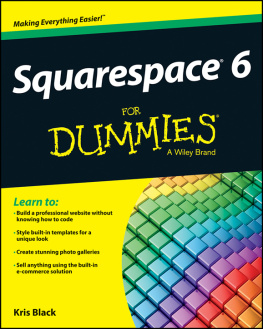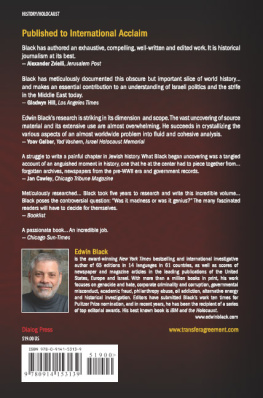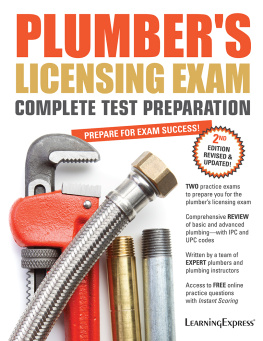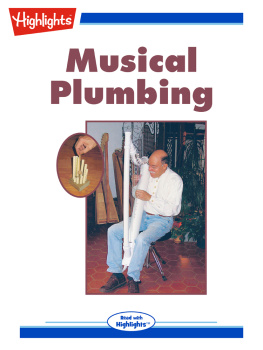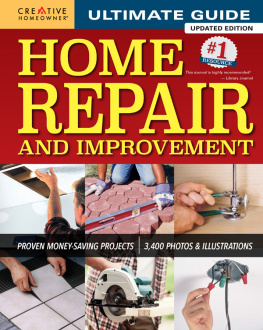The Complete Guide to
PLUMBING
Updated 6th Edition
Current with 2015-2018 Plumbing Codes


First published in 2015 by Cool Springs Press, an imprint of Quarto Publishing Group USA Inc., 400 First Avenue North, Suite 400, Minneapolis, MN 55401 USA
2015 Quarto Publishing Group USA Inc.
Text 2003, additional text 2015
All rights reserved. With the exception of quoting brief passages for the purposes of review, no part of this publication may be reproduced without prior written permission from the Publisher.
The information in this book is true and complete to the best of our knowledge. All recommendations are made without any guarantee on the part of the author or Publisher, who also disclaims any liability incurred in connection with the use of this data or specific details.
Cool Springs Press titles are also available at discounts in bulk quantity for industrial or sales-promotional use. For details write to Special Sales Manager at Quarto Publishing Group USA Inc., 400 First Avenue North, Suite 400, Minneapolis, MN 55401 USA. To find out more about our books, visit us online at www.coolspringspress.com.
Digital edition: 978-1-62788-652-9
Softcover edition: 978-1-59186-636-7
Cataloging-in-Publication Data on file with the Library of Congress
Acquisitions Editor: Mark Johanson
Design Manager: Brad Springer
Layout: Danielle Smith-Boldt
Technical Reviewer: Bruce Barker
Photography: Rau + Barber Photo
Assistance: Brad Holden, Alexandra Burniece, Natalie Williams
The Complete Guide to Plumbing
Created by: The Editors of Cool Springs Press, in cooperation with BLACK+DECKER. BLACK+DECKER and the BLACK+DECKER logo are trademarks of The Black & Decker Corporation and are used under license. All rights reserved.
NOTICE TO READERS
For safety, use caution, care, and good judgment when following the procedures described in this book. The publisher and BLACK+DECKER cannot assume responsibility for any damage to property or injury to persons as a result of misuse of the information provided.
The techniques shown in this book are general techniques for various applications. In some instances, additional techniques not shown in this book may be required. Always follow manufacturers instructions included with products, since deviating from the directions may void warranties. The projects in this book vary widely as to skill levels required: some may not be appropriate for all do-it-yourselfers, and some may require professional help.
Consult your local building department for information on building permits, codes, and other laws as they apply to your project.

Contents

Introduction
P lumbing is a large and varied DIY category. As you explore it, youll find that the tasks you encounter can differ in difficulty, just as taking a pop quiz in math differs from getting a PhD in physics. Fixing that drip in your sink drain might be as simple as tightening the compression nut on your P-trap: about a ten-second job. But running new lines for that extra bathroom youve been wanting in the basement? Youre looking at jackhammers, dumpsters, multiple inspections, and many weeks of hard labor. But as variable as the jobs we lump into the plumbing category are, they have one important thing in common: doing the job yourself can save you a ton of money.
The key to doing the work yourself is twofold: you need ambition, and you need good information. The ambition is pretty much up to each homeowner, but when it comes to information, were here to help. For more than a decade, BLACK+DECKER The Complete Guide to Plumbing has been the leading plumbing manual for do-it-yourselfers. Now in its updated 6th edition and boasting one million copies sold, it is the clearest and most complete plumbing book you can own. From its easy-to-understand explanations of how modern plumbing works to its clear how-to photos of the most common home plumbing projects, this is the only plumbing book youll need to become master of your home plumbing system.
This edition of The Complete Guide to Plumbing has been revised and updated to conform to national plumbing codes in effect from 2015 through 2018. National plumbing codes change every three years, and we pay attention to whats new so you dont have to. The truth is, though, most of the national code updates are aimed at large commercial buildings and multi-unit dwellings, not single-family homes. Many code changes apply only to new construction. But codes also change for a reason, and the reason is almost always to improve safety. Thats why we think monitoring the changes and reporting them back in the form of updated editions of our book is so important. Your municipal building department may not have adopted the changes yet, but we think you should. When it comes to the safety of your family, we always urge you to fall on the side of code-plus.
It isnt codes alone that prompt us to make sure our DIY books stay as current as possible. Its also convenience. Every year, manufacturers and toolmakers come out with new products and ideas that are specifically designed for the home DIYer. Some are better than others, but we watch them closely, and when we see a better way to accomplish your goal with a greater likelihood of success, well show it to you. Take flexible supply tubes, for exampleit wasnt long ago that appliances and fixtures were supplied with water and gas in rigid pipes. Rigid pipes (and even so-called flexible copper tubing) is reliable, but every time you move your dishwasher or bump your water heater, you risk breaking the connection or kinking the tubing. Because most codes now allow flexible gas and water supply tubing for hook-ups, weve taken care to show how hook-ups are being made with these simple products wherever it makes sense. Thats why were confident that when you use this book as a guide for any home plumbing job, you can be assured that youre getting the latest and best information.

The Home Plumbing System
B ecause most of a plumbing system is hidden inside walls and floors, it may seem to be a complex maze of pipes and fittings. But spend a few minutes with us and youll gain a basic understanding of your system. Understanding how home plumbing works is an important first step toward doing routine maintenance and money-saving repairs.
A typical home plumbing system includes three basic parts: a water supply system, a fixture and appliance set, and a drain system. These three parts can be seen clearly in the photograph of the cut-away house on the opposite page.


